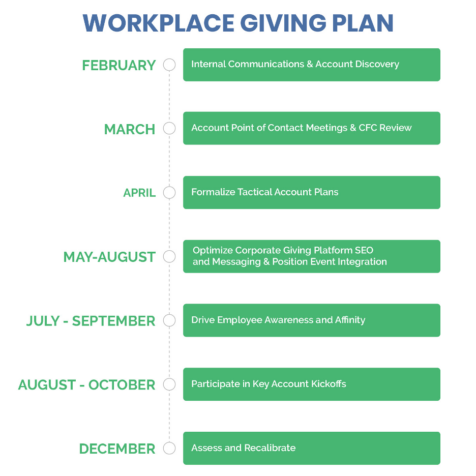6 Tips for Building a Successful Workplace Giving Strategy

As a nonprofit or educational institution, you know firsthand the importance of fundraising to support your mission programming. One often-overlooked opportunity, however, is workplace giving—a form of corporate philanthropy where companies give to and encourage their employees to support organizations like yours.
Building a successful workplace giving strategy can provide your organization with a reliable source of funding, deepen supporter relationships, and increase awareness of your cause. Still, it can be challenging to navigate the complexities of workplace giving without a solid foundation of knowledge on the topic.
In this guide, we’ll explore six tips to help your team build a successful workplace giving strategy that maximizes your impact and engages individual donors and corporate partners alike. These include the following practices:
- Understand typical workplace giving programs.
- Establish actionable goals and craft a plan to achieve them.
- Leverage donor employment details to uncover opportunities.
- Inform supporters about their role in workplace giving.
- Save time and amplify results with automation technology.
- Develop corporate relationships beyond workplace giving.
From familiarizing yourself with various giving opportunities to cultivating partnerships with businesses in your network, these tried-and-true tips will help your organization create a workplace giving strategy that benefits both your mission and the companies that support it.
Let’s get started with the basics.
1. Understand typical workplace giving programs.
The most significant factor that defines workplace giving is the essential role that a company’s employees play in its philanthropic initiatives. There are a ton of programs available, and a thorough understanding of the opportunities can allow your team to best prepare for and pursue them.
Here are a few of the most common program types you might encounter:
- Employer matching gifts: Many companies offer to match their employees’ donations to nonprofit organizations, often doubling or even tripling the amount of the original gift. Donors love seeing their gifts stretch farther for a cause they care about, and they’re even likely to give more when they know a match is available.
- Volunteer grants: Similar to matching gifts, some employers also provide charitable grants when their team members volunteer a certain number of hours with an organization. These are sometimes known as “dollars for doers” and can be an excellent way to encourage and incentivize volunteerism.
- Payroll deductions: When a company offers a payroll deduction program, employees can have a set amount of money automatically deducted from their paychecks and donated to a chosen nonprofit organization. This program can even go hand in hand with matching gifts when a company agrees to match these deducted donations!
Though these are some of the most-offered examples of workplace giving, the possibilities are endless—and can vary significantly from one employer to the next.
Other initiatives include charitable giving stipends (a company gifts funds to employees to contribute to their favorite organizations), annual fundraising campaigns (internal fundraising efforts hosted by a business on behalf of one or more nonprofit groups), disaster relief efforts, and more.
The bottom line is this: the more your team knows about the workplace giving opportunity, the better you can develop a strategy that leverages available programming within your support network.
2. Establish actionable goals and craft a plan to achieve them.
Like any new initiative, defining clear goals is an essential prerequisite to workplace giving success. Otherwise, you won’t be able to determine when you have succeeded.
We recommend following the SMART framework, which means setting goals that are…
- Specific
- Measurable
- Attainable
- Relevant
- Time-bound
Here’s an example of a smart goal that adheres to the above criteria: To collect $5,000 through a combination of corporate matching gifts and volunteer grants by December 31st.
Once you’ve established a goal aligning with your organization’s reach, resources, and overall objectives, you’ll need to determine a plan to get there. A well-crafted plan will help your team navigate the workplace giving process, prioritize related tasks, and track progress toward the finish line.
To get started, consider this sample workplace giving plan; then, build out each phase to craft a clear roadmap for success that fits your organization’s efforts.

As you develop your roadmap, you’ll want to identify who will be responsible for each task—and how progress will be tracked and reported—to ensure no wires are ultimately crossed.
3. Leverage donor employment details to uncover opportunities.
More than likely, you’ve been using your fundraising technology to collect data and build detailed donor profiles in your CRM. However, one piece you may or may not have tracked is your donors’ employment information.
But this is a vital piece of the puzzle! By understanding which companies your donors work for, you can identify opportunities for specific workplace giving programs and other philanthropic initiatives.
Here are a few ways you might uncover your donors’ employment details for those whose information is not already on file:
- Collect employment data within donation forms. Include an optional field on the donation form that asks each donor to provide the name of their employer. (Hint: Briefly summarize the context as identifying workplace giving opportunities to encourage donors to share the information.)
- Check your database for employer affiliations. Even if you haven’t explicitly collected employment information, you may have donor data that allows you to infer it. For example, an individual who contributes using the email address “jake@thehomedepot.com” likely works for Home Depot—and thus would qualify for a matching gift.
- Use social media. Many people list their employers (and other helpful information like job titles) on their social media profiles. More specifically, LinkedIn is a great place to check! Remember, though, that manual research like this likely isn’t sustainable, so we recommend retaining this strategy for your highest-dollar donors.
- Consider an employer appends service. A data appends provider may be able to help you fill in the blanks for some donors for whom you’re not able to locate employment information on your own. You’ll provide the appends service with the information you have about an individual (e.g., name, contact information, giving history, etc.), and they’ll scan it against several publicly and privately held databases to—hopefully—uncover the information you need.
Once you have donor employment details, you’ll want to compare this information against companies that offer workplace giving programs. Consult lists of top matching gift and volunteer grant companies and look for any overlap with your donors’ employers. That overlap is where you’re likely to identify available opportunities for your organization.
4. Inform supporters about their role in workplace giving.
We know that a company’s workplace giving initiatives are reliant on its employees taking part. But many eligible employees don’t know that! Thus, if you want to encourage your donors to participate in their employers’ available programming, you must proactively educate them about the opportunities.
This can follow a few methods: namely, mass and personal communications.
Your mass messaging should consist of general educational content regarding workplace giving. For example, you might share impactful statistics on your social media channels, incorporate broad calls to action in marketing newsletters that ask supporters to look into their employers’ programming, and more. Inform supporters that tens of thousands of companies set funding aside to contribute via workplace giving programs—but if their employees don’t participate, that money is going unclaimed.
Then, there’s your personalized outreach. This is where the employment information you previously collected will come in handy. Now, you can provide supporters with their specific companies’ workplace giving information. For example, if you determine that an individual works for the Walt Disney Company, you can share materials regarding the company’s matching gifts, volunteer grants, and more. And encourage them to get involved!
Keep in mind that you’ll want to share the most detailed information possible to best inspire action. Include specific program guidelines (like minimum and maximum donation amounts, volunteer hour thresholds, and qualifying nonprofit causes) as well as direct links to the online submission portals supporters will use to complete their requests.
5. Save time and amplify results with automation technology.
According to research from Nonprofits Source, over 80% of nonprofits have difficulty building strong workplace giving strategies with limited staff and resources. Luckily, automation software can go a long way toward boosting productivity and efficiency in a nonprofit or school’s corporate fundraising efforts.
These automations enable organizations to…
- Quickly identify donors who qualify for matching gifts, volunteer grants, and more;
- Integrate workplace giving information directly into the online giving experience to catch donors at their highest level of engagement;
- Trigger post-transaction email streams that provide personalized and company-specific workplace giving information to drive participation;
- Track workplace giving requests through the process to follow up as necessary and forecast incoming revenue;
- Collect and analyze workplace giving data that can be used to celebrate successes and locate areas with room for improvement.
Overall, automation helps ensure qualifying donors receive targeted and timely outreach, provides much-needed information, and guides them through the process with ease. And it all happens without having to lift a finger or worry about possible matches slipping through the cracks, ultimately resulting in increased revenue collected through the programs.
Plus, your team can reallocate time and energy—previously devoted to manual workplace giving initiatives—to other mission-critical efforts.
6. Develop corporate relationships beyond workplace giving.
Workplace giving programs can be a fruitful funding source for your organization—but they’re not the only kind of corporate philanthropy opportunity you can (and should) pursue. They can, however, help your team get its foot in the door when establishing and strengthening other corporate relations.
This might include…
- Event or project sponsorships
- Cause-related marketing campaigns
- Corporate grants
- In-kind donations
- And more
By working closely with companies to identify shared values, goals, and audiences, you can build long-lasting partnerships that benefit all parties involved.
(Hint: the companies your donors work for can be some of your most valuable prospects for identifying and pitching broader corporate partnerships!)
Workplace giving opportunities continue to grow as employees and consumers increasingly demand CSR practices from the companies they work for and buy from. If your organization has yet to craft a strategy for this type of funding, there’s no better time to do so.
Be sure to implement the above tips and tricks as you build, introduce, and finetune your workplace giving plan. You’ll set your team up for ongoing success with donors, corporate partners, and more.
Good luck!

